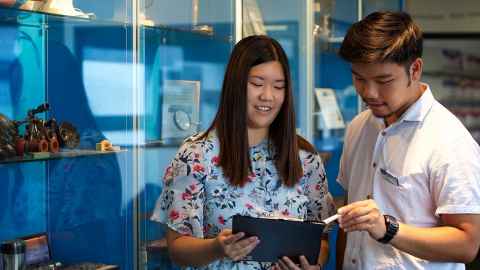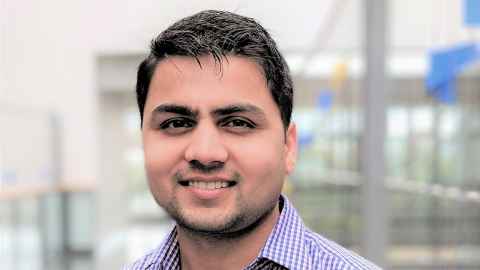Doctoral study in Optometry and Vision Science

Why study with us?
- The School of Optometry and Vision Science is home to several distinct research groups undertaking a wide range of leading-edge clinical, biomedical and basic vision research.
- Our research groups are staffed by internationally recognised scholars who engage in extensive collaboration within Australasia, Europe, the United States and Asia.
- Our staff includes academic leaders in the fields of visual neuroscience, clinical vision science, molecular vision, myopia, colour vision, biology of the retina and community eye health.
- Our doctoral programmes are designed to provide opportunities to work within our diverse range of vision research and to work closely with our first-class researchers.
- Students have both access to state-of-the-art laboratories and the opportunity to run studies within the University of Auckland Optometry Clinic, which is located with the school on the Grafton Campus.
Research opportunities
When you join us for your doctorate in the School of Optometry and Vision Science, you'll be part of a high-calibre research community and trained to conduct vision research to the very highest standard. This will include the opportunity to publish papers, attend international conferences and develop your network in academia and industry.
We welcome research proposals in topics relating to our key research specialisations:
Myopia laboratory
- Investigating the design, use and treatment of special contact lenses to slow the progression of myopia (short-sightedness).
Neural plasticity
- Exploring the brain’s remarkable ability to adapt to changes in the visual environment. For example, research on amblyopia (‘lazy eye’, which affects 3% of children) has led to video game treatments that tap into neural plasticity to improve vision and are proving a popular alternative to eye-patching.
Virtual reality
- Virtual reality (VR) is an increasingly popular consumer technology that offers unique opportunities for testing vision in complex/realistic visual environments. Ongoing projects in the school explore the use of VR in a range of settings: from measuring peripheral vision to exploring the impact of phone-use on driving.
Eye tracking
- Using reflexive eye movements to estimate useful vision in groups that can be difficult to assess (such as children). Tracking where children look as an indicator of neuro-developmental conditions such as autism spectrum disorder.
Retinal degeneration
- Investigations into mechanisms of retinal degeneration in the aging eye, including diabetes and visual function loss in Alzheimer’s disease.
Colour vision
- Exploring the visual experience of people with abnormal colour vision, and developing equipment to help certain professionals (e.g. optometrists) overcome resulting difficulties. Studies of colour vision in animals.
Clinical research
- Evaluating factors that influence visual development in infants and children. Comparing novel and established methods of measuring refractive error.
Community Eye Health
- Improving knowledge and understanding of eye health in Aotearoa. Developing and testing solutions to improve access to eye health services for all, with a particular awareness of Māori health advancement needs.
Our people
Pursue your topic with us and benefit from exceptional standards of support and supervision from internationally recognised researchers. Below we outline our staff’s key research interests.
Dr Andrew Collins (Head of School)
Development of refractive error, the measurement of visual acuity, and the relationship between aniseikonia and amblyopia. Understanding how the environment, particularly light exposure, influences the development of myopia with the ultimate aim of producing effective interventions that will reduce the progression of refractive error in humans. The role of vision in transportation.
Associate Professor Monica Acosta
Cell and molecular aspects of eye diseases, understanding retinal function and development in the normal and diseased retina, characterising cell death pathways and candidate natural drugs to aid the understanding and provision of therapies for blindness as observed in inherited retinal dystrophies and in age-related macular degeneration.
Amblyopia and naturally occurring myopia. New treatment regimes for amblyopia in children and adults.
Professor Steven Dakin
Understanding how vision works and measuring vision in the clinic using eye-tracking. Treating amblyopia using video game technology and exploring the neural basis of this condition using brain imaging. Use of eye-tracking to diagnose developmental conditions and age-related eye disease.
Binocular vision disorders, including amblyopia. Functional consequences of binocular vision disorders. Clinical applications of eye tracking. Perceived image size differences between eyes (aniseikonia), particularly in patients with amblyopia and/or pathological suppression. Clinical vision testing. Use of technology to support/enhance clinical teaching.
Development and progression of childhood myopia. The physiological processes that control eye size and normally ensure that the eye remains emmetropic (i.e. without refractive error) as it grows.
Associate Professor Jacqui Ramke
Equity and eye health, eye health services research, epidemiology, analysis using routinely-collected eye health services data (including linkage of large datasets)
Associate Professor Samuel Schwarzkopf
Contextual processing, visual illusions, retinotopic mapping, population receptive field modelling, functional MRI, visual psychophysics, perceptual grouping, visual awareness, individual differences.
Emmetropisation, myopia progression, cephalopod vision, use of technology for visual assessment. Using technology - including virtual reality, eye-tracking, arterial spin labelling magnetic resonance imaging (ASL-MRI), and multifocal electroretinograms (mf-ERG) - to create fast and objective measures of visual function and ocular response. Applying such techniques to conditions such as myopia, diabetic retinopathy and age-related macular degeneration.
Associate Professor Ehsan Vaghefi
Developing magnetic resonance imaging techniques to monitor fluid flux inside the ocular lens. Clinically applied physiological optics, cataracts research, ocular biomedical imaging, ocular computational modelling.
Dr Misha Vorobyev
The relationship between colour vision and the colourful patterns that adorn plants and animals. Chromatic and achromatic vision in birds and fish, insect colour vision in relation to flower colours, ecological relevance of primate colour vision, neural noise and encoding of visual information.
Past research topics
- "Investigation of Methods for Inhibition of Myopia Progression in Children" | Supervised by Dr John Phillips
- "Visual Function in Virtual Reality" | Supervised by Dr Phillip Turnbull
- "Investigation of the Effects of Gap Junctions on the Lens Physiological Optics Using Magnetic Resonance Imaging" | Supervised by Dr Ehsan Vaghefi
- "A Comparison of Spectral Domain and Swept Source Optical Coherence Tomography" | Supervised by Dr Hannah Kersten and Dr Lily Chang
- "Detecting Amblyopia in Children Using a New Visual Acuity Test on a Tablet Computer" | Supervised by Dr Lisa Hamm and Professor Steven Dakin
- "The Association Between Color and Music" | Supervised by Dr Misha Vorobyev
- "Comparison of Predicted and Measured Depth-of-Field for Presbyopic Corrections in Progressive Addition Lenses" | Supervised by Associate Professor Robert Jacobs
- "Reconstructing the Subjective Perception of Object Size" | Supervised by Associate Professor Sam Schwarzkopf
- "Treatment and Characteristics of Interocular Suppression in Amblyopia; Molecular and Functional Evidence of Alzheimers Disease in the Eye: Experimental and Clinical Application; Deprivation Amblyopia" | Supervised by Dr Joanna Black
- "Neurochemical Changes in Retinal Degeneration" | Supervised by Dr Monica Acosta
Experience doctoral study

Safal Khanal
Doctoral candidate
"I did my undergraduate training in Nepal at Tribhuvan University and graduated with a Bachelor of Optometry degree in 2012 before moving to the Philippines, where I completed my Doctor of Optometry training. Following graduation, I worked in a private practice and a conjoint optometry-ophthalmology clinic in Nepal, besides volunteering for several eye-care missions.
"During my time in clinical practice and community optometry, I came across many patients with myopia (near-sightedness) - a progressive sight-threatening condition with no effective treatment. I then contacted Dr John Phillips at the Auckland Myopia Lab with an interest in undertaking research, which could inform ways to effectively reduce and treat myopia.
"Currently, I am studying towards a PhD degree in the School of Optometry and Vision Science at the University of Auckland, where I am applying my optometry skills and utilizing advanced imaging techniques to research various treatment methods for myopia."
Scholarships and awards
There are several scholarships you may be eligible for when you decide to pursue your doctoral studies in Optometry and Vision Science.
Contact us
Do you want to chat further about your options for studying a PhD in optometry or a related field? Contact Dr Monica Acosta:
Telephone
Within New Zealand: (09) 923 6069
Overseas: +64 9 923 6069